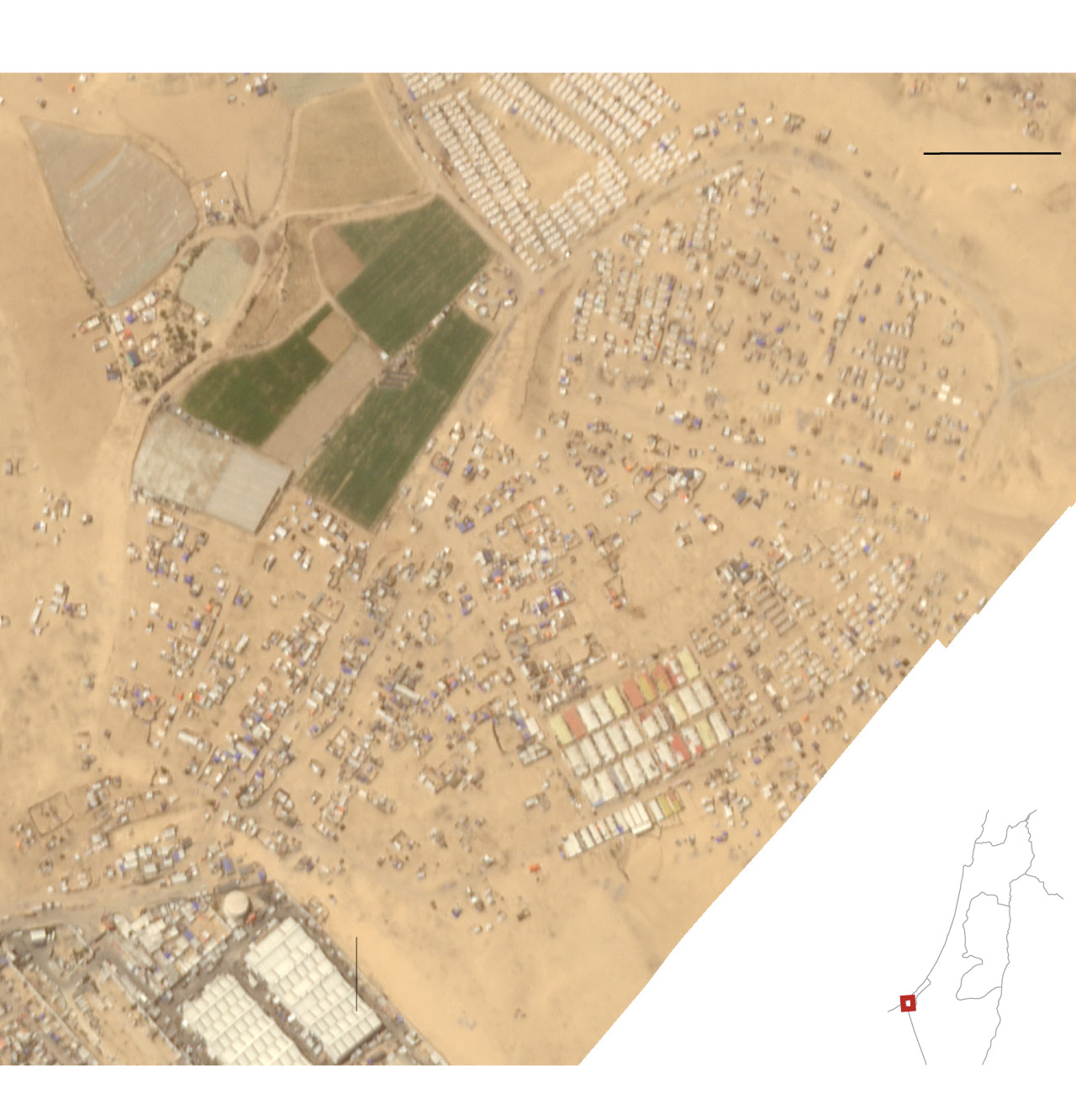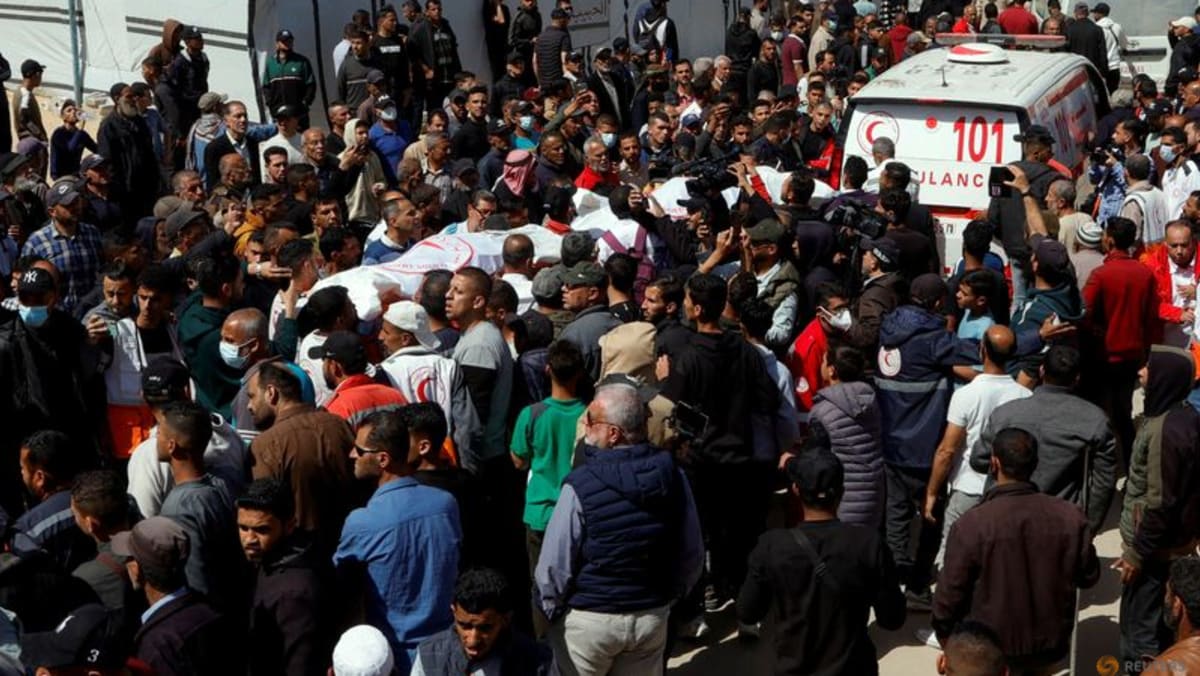Tal al-Sultan tent camp as of May 24
SAMUEL GRANADOS/THE WASHINGTON POST

Tal al-Sultan tent camp as of May 24
SAMUEL GRANADOS/THE WASHINGTON POST
In an address to parliament Monday, Israeli Prime Minister Benjamin Netanyahu called the Rafah strike a “tragic accident.” It was a departure from public statements by the Israeli military, which had previously referred to a targeted strike on a Hamas compound using “precise munitions” and “precise intelligence.”
The Israel Defense Forces said two militants were killed in the attack, including the commander of Hamas operations in the West Bank. “There were many measures taken before the attack to minimize harm to non-involved people,” the IDF said Monday, adding that the incident was under investigation.
GET CAUGHT UP
Summarized stories to quickly stay informed
A spokesperson for the White House National Security Council, speaking on the condition of anonymity to discuss a sensitive matter, said the images from Rafah were “heartbreaking.” “Israel has a right to go after Hamas,” the spokesperson said, noting the killing of the two militants, but “Israel must take every precaution possible to protect civilians.”
The United States has yet to weigh in publicly on Friday’s ruling by the International Court of Justice ordering an immediate halt to Israel’s offensive in Rafah. Nearly a million Palestinians have been displaced this month, the vast majority from Rafah, which had been a place of last refuge for tens of thousands of families.
On Sunday night it was the site of one of the most horrifying scenes of the war.
Mohammad Al-Haila, 35, was headed to buy some goods from a local vendor when he saw a huge flash followed by successive booms. Then he saw the flames.
“I felt like my body was freezing from fear,” Haila, who was displaced from central Gaza, told The Washington Post by phone.
He ran toward the area to search for relatives.
“I saw flames rising, charred bodies, people running from everywhere and calls for help getting louder,” he said. “We were powerless to save them.”
Haila lost seven relatives in the attack. The oldest was 70 years old. Four were children.
“We were not able to identify them until this morning because of the charred bodies,” he said. “The faces were eroded, and the features were completely disappeared.”
Ahmed Al-Rahl, 30, still hears the screams.
He and his family were preparing for bed when they heard several large explosions, said Rahl, who is displaced from the north. Their tent shook. Mass confusion took over the camp.
“No one knew what to do,” he said. “Children who were with their families in those tents rushed to us, asking us to save their parents who were burning.”
Rahl had a fire extinguisher and rushed to help.
“I didn’t know what to do to help people as they burned,” he said. Around him there were “dismembered bodies, charred bodies, children without heads, bodies as if they had melted,” he said.
There was no water to extinguish the fire, which consumed the cloth and plastic tents. Gas canisters used for cooking exploded, Rahl said.
“I saw with my own eyes someone burning and crying for help, and I could not save his life,” he said.
Mohammad Abu Shahma, 45, rushed to check on his extended family when he heard that the fire was spreading. His brother’s tent was about a quarter-mile from the worst of the carnage. Shahma figured he must be safe.
He found his brother, a father of 10, and his 3-year-old niece, Palestine, dead. There was blood everywhere, Shahma said. Shrapnel had struck his brother in the chest and neck; the child had been hit in the head. Another daughter, 9-year-old Jana, was injured.
Around 10 p.m. Sunday, the dead and wounded began pouring into the area’s few field clinics.
Twenty-eight people were dead on arrival at a temporary emergency trauma center run by Doctors Without Borders less than two miles from the strike site, according to Samuel Johann, the group’s emergency coordinator in Gaza. The clinic treated 180 additional patients with severe burns, shrapnel wounds, missing body parts and other traumatic injuries, he said.
Farther west, at a clinic run by International Medical Corps, plastic surgeon Ahmed al-Mokhallalati described family members searching desperately for loved ones.
One little girl, he said, was asking everyone she passed if they had seen her parents. Mokhallalati said they were among the dead.
Many people came in with horrific wounds and required amputations, he said, as shrapnel flew across the camp and pierced people’s tents. Over a grueling, relentless night, he and his colleagues conducted at least 12 hours-long surgeries, Mokhallalati said.
They ran out of medical gloves, gowns and other basic supplies to treat open wounds. “We are running out of everything, literally,” he said
Patients needing further care had few places to go, he said. Rafah’s two main hospitals have been evacuated. The smaller Kuwait hospital said Monday that it had to close after repeated attacks. One of the only options left was al-Aqsa Martyrs Hospital, a rough ride away in central Gaza.
Mokhallalati recounted operating on a 6-year-old girl with deep shrapnel wounds that stretched from her thigh to her abdomen. She died early Monday morning, he said.
The makeshift camp in Tal al-Sultan was outside Israel’s designated evacuation zone in Rafah, and residents were not ordered to leave before the strikes.
The area was at the edge of, but not included in, a map of humanitarian zones provided by the IDF online and in recent announcements. Gazans, however, short on bandwidth and cellphone battery power, often rely for information on word-of-mouth and Arabic-language pamphlets dropped by the IDF. Residents complain that the evacuation orders and accompanying maps are confusingly worded and difficult to follow. Many believed they were in a safe place.
In its statement, the IDF said “the attack did not take place in the humanitarian area in Al Mawasi,” referring to a coastal region northwest of Rafah where it has ordered evacuees.
New arrivals to Mawasi have told The Post the area is desolate, overcrowded and devoid of even the most basic services. Some families, many who have already been uprooted numerous times during the war, decided to stay in Rafah.
French President Emmanuel Macron said Monday that he was “outraged by the Israeli strikes that have killed many displaced persons” and called for “an immediate cease-fire.”
Canadian Foreign Minister Mélanie Joly also demanded a cease-fire, saying, “This level of human suffering must come to an end.” A spokesperson for the ministry said the country was following up on reports that two Canadian citizens were among the dead in Rafah.
The Foreign Ministry in Germany, one of Israel’s most stalwart supporters in Europe, said in a statement on X on Monday that the images from the attack were “unbearable” and that “the civilian population in Gaza must urgently be better protected.”
Shahma spent Monday packing up. His extended family of 50 people had decided that women and children would move to Mawasi, he said, and the men would stay in nearby Khan Younis.
“We did not even find time to grieve for those we lost,” he said. “All that matters to us now is to save those who remain.”
Haila spent the day searching scorched corpses at the clinic in Tal al-Sultan for any sign of his missing family members.
“What we live in this life cannot be described,” he said. It was like being “on the waiting list” to die.
Harb reported from London. Sarah Dadouch in Beirut, Rachel Pannett in Wellington, New Zealand, Niha Masih in Seoul, Lior Soroka in Tel Aviv, Hazem Balousha in Cairo, Amanda Coletta in Toronto and Tyler Pager in Washington contributed to this report.




















Discussion about this post